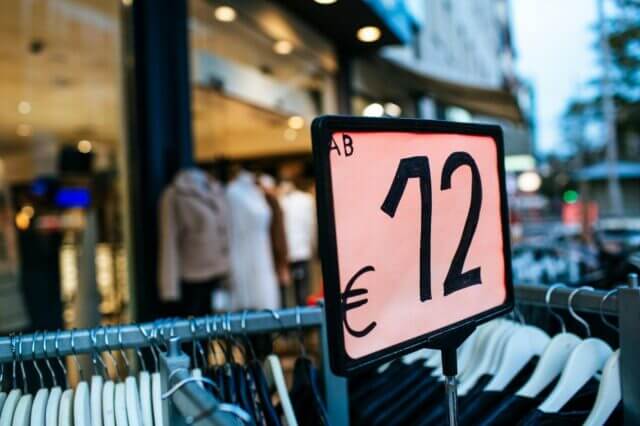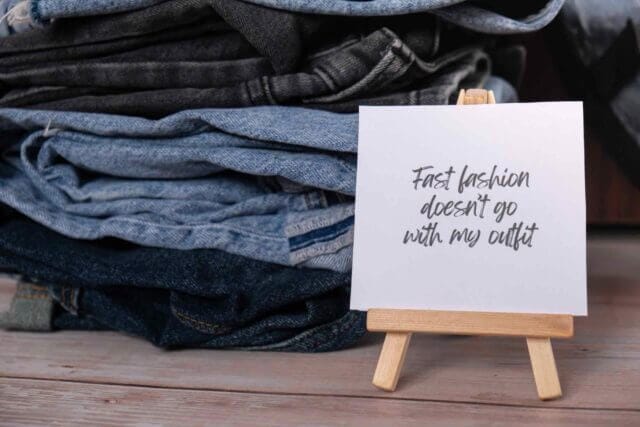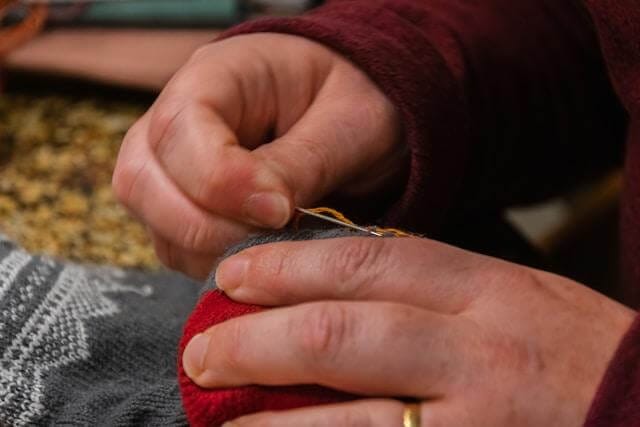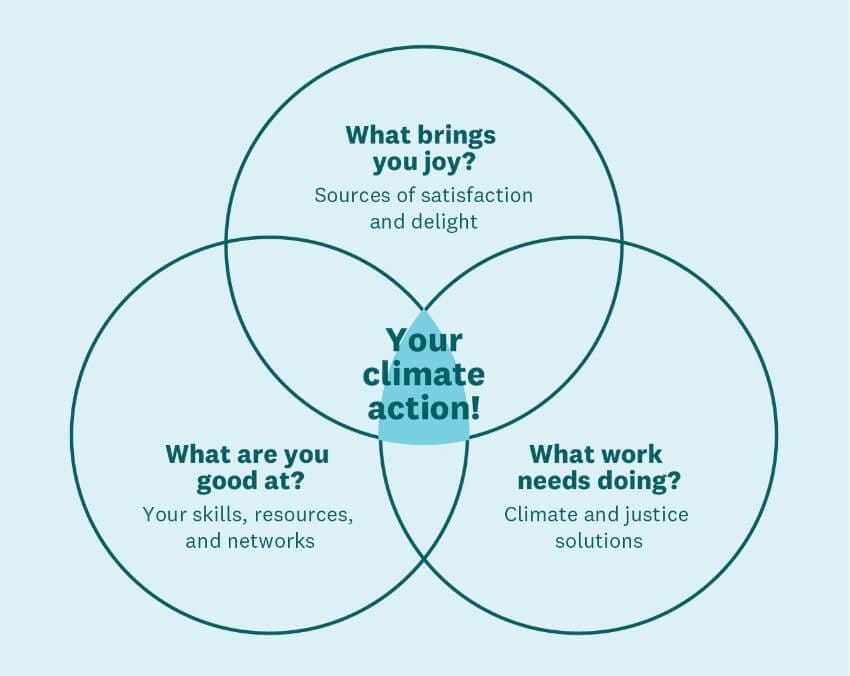Have you felt helpless knowing how much fashion affects the climate and its people? Have you noticed the key culprit of this may be fast fashion? (even if Luxury is also a big criminal in terms of slave labor). Join us in figuring out how!
There is no ‘one solution’, but we can all do our part. Have you ever thought about the power you have to help tackle these issues?

What is Fast Fashion?
Fast Fashion is a business model in which trendy styles are produced at increasingly higher speeds, with disposable quality, in astronomical quantities, for low prices. Its garments are made using unnecessary resources and toxic chemicals. They are so inexpensive because the companies that make them are grossly underpaying or stealing garment workers’ wages.
If you are not certain which brands are fast fashion, start with our guide to 50 fast fashion brands to avoid. Brands like Cider, Zara, Forever 21, H&M, SHEIN, and Halara are examples of fast fashion.
In the past, I have also succumbed to the seduction of the fast fashion industry because I did not know the damage they caused, but more importantly, because I did not know their tactics. These brands are experts at using our human nature to make us believe we need that trendy transparent skirt.
If you too have felt it’s hard to have the willpower to buy less, it’s because they make it very attractive to do so by using our psyche.
How do they do it? We spoke to Brittany Sierra, Founder & CEO of the Sustainable Fashion Forum & the Green Behavior Podcast, who is also a fashion psychology enthusiast, to gain more insight into that.
How have fast fashion brands used psychology to influence our behavior into valuing overconsumption and newness?

“As humans, we are inherently drawn to newness. Fast fashion brands capitalize on this by amplifying the thrill of acquiring new items through tactics like aggressive marketing, frequent product releases, limited-time offers, and social media promotions.
These tactics create a sense of urgency and scarcity, prompting impulsive purchases. The fleeting satisfaction of buying something new drives consumers to return for more, creating a feedback loop, and perpetuating a cycle of constant consumption.
Likewise, the need for belonging is also deeply ingrained in our human nature and significantly influences our purchasing decisions, especially in the fashion and beauty industries.
Humans have a fundamental need/want to belong to a group, which, from an evolutionary standpoint, provides safety and protection. In the context of fashion, this need manifests as the desire to fit in with peers, adhere to social norms, and be part of a community.
Fast fashion brands strategically utilize social media and influencers to cultivate a sense of community around their products. Through platforms like Instagram and TikTok, they engage directly with consumers, creating an interactive and immersive brand experience.
Additionally, influencers, who have dedicated followings, play a crucial role by showcasing the latest trends and collections, effectively acting as brand ambassadors. These influencers not only promote products but also share styling tips, personal endorsements, and lifestyle content that resonates with their audience, making the brand more relatable and aspirational.
This strategy taps into the concepts of social proof and social signaling. Social proof is the psychological phenomenon where people look to the actions and behaviors of others to guide their own decisions. By leveraging influencers and encouraging user-generated content, fast fashion brands create a perception of popularity and desirability around their products. When consumers see influencers and peers endorsing and wearing these brands, it validates their choices and encourages them to follow suit, reinforcing the notion that these brands are fashionable and socially acceptable.
Social signaling is the act of using products or behaviors to communicate one’s status or identity to others. Fast fashion brands enhance this by fostering a communal atmosphere where customers can showcase their outfits and styling, signaling their fashion sense and social alignment with trendy, in-demand styles. This approach not only drives sales but also builds brand loyalty, as consumers feel they are part of an exclusive, fashionable community, further reinforcing their social identity and status through their association with the brand.”
-Brittany Sierra

Why is Fast Fashion Bad?
Its consequences are far-reaching for the people involved in their clothing production and for our planet. Negative impacts include worker harassment, diseases due to toxic chemical use, poverty, wage theft, increased greenhouse gas emissions, biodiversity loss, as well as resource and soil depletion, among others.
Let’s dig in.
Environmental Impact of Fast Fashion
The fashion industry is responsible for 4-8% of Global Greenhouse Gas Emissions, which contribute to climate change. The average consumer buys 68 items a year and disposes of them after wearing them once or twice, filling landfills in poor neighborhoods or in the Global South.
These consumer habits result in even higher production levels. Additionally, the IUCN estimated that, in 2017, 35% of microplastic pollution came from washing synthetic textiles made of fabrics like polyester, which is widely used in fast fashion.
Labour Issues of Fast Fashion
This is coupled with the mistreatment and underpayment of garment workers globally, as 93% of fashion companies don’t pay garment workers a livable wage. This also happens locally and largely affects women who are 60% of garment workers, and even 80% in some regions.
The US government uncovered that some clothing makers are paid 1.58 dollars per hour in Southern California, where the minimum wage should be 15. This is why you can get that cute top so cheaply.
If you want to learn more about how fast fashion harms people and the planet, check out our guide. Now let’s talk about how to stop fashion!
How to Stop Fast Fashion? Join the Slow Fashion Movement

Opting out of fast fashion does not mean opting out of fashion altogether. It just means taking a different approach to it, one said approach is to join the slow fashion movement.
How? By changing your behavior, taking care of the clothes you have, and thrifting or supporting ethical brands when buying new clothes.
It is not only fast fashion brands that can use behavioral psychology in their favor. To gain more insight into how you can take advantage of it for good we once again spoke to Brittany Sierra, here is what she said.
How can we as consumers use our behavior and that of our peers to stop fast fashion?
“Recognizing and understanding the tactics used by fast fashion brands is a great first step in resisting their influence. When you feel the urge to buy something, take a moment to think about why you want it. Pausing to reflect on your motivations helps you make more conscious decisions and resist impulse buying. Additionally, it’s important to identify the emotional triggers that lead to shopping in the first place like stress or boredom. Instead of shopping, find alternative ways to cope with these emotions.
Reducing your exposure to fast fashion temptations can also be helpful—unsubscribe from their marketing emails and unfollow them on social media. By making these small changes, you can shift your behavior and encourage those around you to do the same.”
-Brittany Sierra

13 Ways to Join the Slow Fashion Movement and Stop Fast Fashion
If you don’t know where to start to help stop fast fashion, we made a list of simple actions you can take to make an impact. Know a few more? Let us know in the comments.
1. Stop Buying Fast Fashion: Shop In Your Closet
First, look at what you already own. See what you wear the most and start with that, creating new combinations from it. Remember, the most sustainable option is always what is already in your closet.
Rewearing your clothes can be the antidote to the fact that 25% of our closet is left unused, according to the Hot or Cool Institute. This is a sad statistic not only because it leaves great pieces unloved, but also because re-wearing what you own can have a huge effect on reducing fashion CO2 emissions and conserving virgin natural resources.
2. Simplify Your Wardrobe
Another option to consider is building a capsule wardrobe consisting of 10 to 20 timeless, long-lasting pieces. These versatile items are carefully selected to complement each other seamlessly, ensuring they can be mixed and matched effortlessly.
Whether you’re heading to a formal event or a casual outing, these pieces can be dressed up or down accordingly, offering flexibility and style in any situation.
One thing to keep in mind is that you don’t necessarily have to buy a whole new wardrobe to achieve this.
3. Take Care of Your Clothes

Properly caring for your clothes is crucial for maintaining their quality and sustainability. Follow care labels for washing and drying instructions, and sort clothes by color and fabric type to prevent damage. Opt for eco-friendly detergents and cold water washing to reduce energy consumption.
Air-drying clothes conserves energy and extends their lifespan. Store garments in a cool, dry place away from sunlight to prevent fading. You can also learn how to make clothes, repair, darn, quilt, and better yet, you can do it in a group to make being environmentally friendly more fun / a sociable activity to share with friends. By implementing these practices, you can ensure your clothes last longer while reducing environmental impact.
4. Thrift Instead of Buying Fast Fashion

Go to a thrift store, look for your dream garment on Depop, Poshmark, eBay, ThreadUp, Teleport, or a swap to give a second life to resold or donated items. Do so mindfully, though, as overconsuming secondhand can create issues too. You can also use these platforms to sell your clothes when you no longer want them, instead of throwing them away.
5. When Buying New, Support Ethical Brands
Brand transparency is vital if you are seeking ethically sourced and sustainable products. Key indicators include disclosure of manufacturing locations and fabric sourcing on the website. Assessing materials, water usage, and chemical use is crucial, along with longevity and repairability.
Consider the business model, including recycling efforts, made-to-order options, and BIPOC ownership. Fair treatment of suppliers and employees is essential, as is community involvement.
If doing the research for more ethical brands sounds hard, don’t worry! At Eco-Stylist, we have an online directory of sustainable fashion brands certified because of their transparency, environmental impact, and treatment of people.
Additionally, we have specific guides for ethical alternatives to fast fashion like SHEIN, Zara, or H&M.
6. Share the Fast Fashion Issue with Your Friends
Talk about it with your friends and family!
Fashion Revolution is mapping the climate conversations people are having, get inspired and add yours here. Send them videos on the topic from experts like Aja Barber or Slow Factory.

You can also send things that aren’t academic or all doom and gloom! The SNL Fast Fashion Ad, Patriot Act, John Oliver, and even some TikTok videos posing like CEOs destroying biodiversity, are comedic approaches to spread the word on fashion’s problems and make a heavy topic a little more digestible.
Share content about how to fix your clothes like this one. Attend your local Fashion Revolution events together. Fashion Revolution is a movement that spreads information and lobbies for a better fashion industry. They do panels, swaps, and movie screenings you can join to learn more.
7. Follow Other Sustainable Fashion Creators
Fast fashion and fast media are intrinsically linked, a lot of what we watch and listen to is telling us we are not enough. So instead of looking at SHEIN hauls that probably make you feel like you are not jumping on the latest mob wife trend fast enough, here are some creators you can find some more mindful content on:
For industry discussions and ethical brands:
- A Podcast, ConsciousChatter, or Green Behavior.
- A writer and conscious consumerism activist, Aja Barber.
- A movement, Fashion Revolution.
- A visual storyteller with a BIPOC activism perspective, Adity Mayer.
For plus-size sustainable style inspiration, you can follow the creators below:
- @Madebyalexnyc
- Marielle Elizabeth
- Lydia Morrow
- @thecurvycapsule
8. Instead of Buying Fast Fashion, Let Tech Help You Find Eco-Friendly Alternatives

There are some extensions that you could use to find alternatives to fast fashion when you are searching for a specific item or even to block fast fashion altogether.
For second-hand alternatives, you don’t have to look further than Beni. With the Beni extension, you can see a curated list of secondhand options, sourced from 100 sites. It shows you similar items with the best prices being sold on places like eBay, Poshmark, or the brand’s official retail sites, like Worn Wear from Patagonia, for example.
It can find similar items to unsustainable brands and secondhand alternatives to sustainable brands at a better price because they are on resale. By using it, you can opt out of fast fashion and be part of the circular economy.
We know how tempting it can be to buy those Stradivarius or Cider metallic pants when they turn up on your search, so why not get rid of the temptation altogether by adding a plug that filters out fast fashion brands (really any brand) from your shopping searches? You can make the UBlock extension for Chrome do that for you with a few simple steps. Only one caveat, it works on the shopping section of Google, not a general Google search.
9. Don’t Like Shopping? We Can Shop Sustainable Brands for You

If you do not enjoy the process of looking endlessly for the right piece of clothing or don’t have the time to research what options are ethical, we offer a styling service that sends you monthly or one-time personal shopping suggestions. All you have to do is fill out a style quiz and you will get shopping suggestions in your email that cater to you, for the good of people and the planet.
10. Support Laws that Hold the Fashion Industry Accountable
Right now in the US there are two laws that tackle the issues of fast fashion which you can help make a reality: The FABRIC ACT and The NY Fashion Act.
The FABRIC ACT:
- Under the FABRIC ACT brands will be equally liable and held accountable alongside manufacturers with any wage violations or liquidated damages.
- It will be prohibited to pay per piece and instead, manufacturers will have to pay workers hourly, until meeting the minimum wage.
- It would establish a 40 million Domestic Garment Manufacturing Support Program to pay for improvements, training, and factory equipment. Additionally, it will provide a 30% reshoring tax credit.
The NY Fashion Act:
- The NY Fashion Act requires brands with an annual global revenue of $100 million to: know and disclose their supply chains, set and achieve climate reductions in line with the Paris Agreement, manage chemical use with their suppliers as well, and improve the lives of garment workers.
- Brands that do not comply would be fined up to 2% of annual revenues.
- Funds will benefit workers and communities impacted as well as environmentally beneficial projects.
We encourage you to: sign a petition online for the FABRIC ACT or the NY Fashion Act.
You can also call, email, or text your representatives and your senators. The FABRIC ACT’s website even has a template on what to say and how to find them. We wanted to share it here:
“Hello. My name is [Name]. I live in [City, State] and my zip code is [ZIP CODE]. I am a constituent, and I am calling on the Representative to support and co-sponsor The FABRIC Act, H.R. 8473.
America’s 95,000 garment workers often face wage theft and our apparel manufacturers face unfair competition. The FABRIC Act will level the playing field for responsible business, ensure that garment workers are paid fair wages, and promote much-needed job growth.
By supporting the FABRIC Act, we can accelerate domestic manufacturing and cement the US as the global leader in transparent and equitable clothing production. Thank you for your time.”
11. Become a Remake Ambassador

Remake collaborates with brands, policymakers, and grassroots organizations to drive systemic change and promote ethical and sustainable practices throughout the fashion supply chain. Through storytelling, advocacy campaigns, and community engagement, Remake seeks to create a more just, equitable, and sustainable fashion industry for all stakeholders involved.
Ambassadors organize educational events, host workshops, and lead discussions to raise awareness about the social and environmental impacts of the fashion industry. For instance, they may conduct clothing swaps, where individuals exchange pre-loved items instead of buying new ones, promoting sustainable consumption practices.
Additionally, ambassadors collaborate with ethical brands and local communities to support initiatives that prioritize fair labor practices and environmental sustainability. Through social media campaigns and storytelling, ambassadors amplify voices advocating for a more transparent and equitable fashion industry. They also work to influence policy changes by advocating for legislation that holds fashion companies accountable for their supply chain practices. You can be one of them!
12. Join Our Newsletter
Be the first to know about the latest ethical brands, brands to avoid, exclusive sustainable fashion deals, holiday roundups, as well as tips to dress like you give a damn by joining our Newsletter.
13. Find Joy to Stop Fast Fashion
Still don’t know where to start? Don’t worry, marine biologist and climate change solutions advocate Dr. Ayana Elizabeth Johnson proposed a Venn Diagram structure that can help anyone find their place in the fight to make a more equitable and environmentally sound world. This tool can also be applied to stop fast fashion.

First, make a list of the things that bring you joy. Like, say bringing people together.
Then make a list of the things you are good at like playing music and singing. Make a list of the work that needs doing, like signing petitions and campaigning to pass fashion accountability laws.
This could end up in a concert to raise funds and promote a petition signing, or a viral song on social media about fast fashion that includes a link to the law petition, for example.
Try it out for yourself and see what you come up with!

Adela is a Colombian storyteller, content maker, strategy consultant, & event producer, specializing in sustainable fashion, mental health, and gender issues.










2 thoughts on “How to Stop Fast Fashion and Save the Planet”
Love seeing voices calling for real change in fashion. I believe mindful innovation plays a big role in shaping a more sustainable future—every choice counts.
Absolutely, loved the content, we too are a slow fashion brand